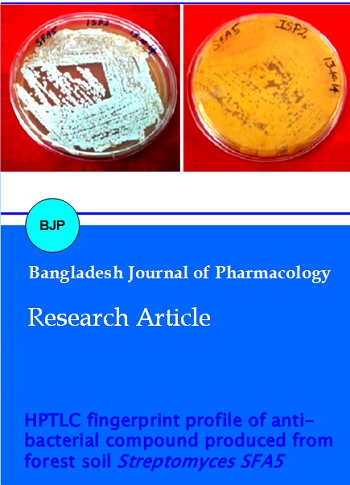HPTLC fingerprint profile of antibacterial compound produced from forest soil Streptomyces SFA5
DOI:
https://doi.org/10.3329/bjp.v11i2.25478Keywords:
Antibacterial, Forest soil, HPTLC fingerprint profile, Streptomyces SFA5Abstract
The present study investigates the presence of antimicrobial compounds from potent isolate Streptomyces sp. SFA5 from the Sabarimala forest ecosystem, Western Ghats, Kerala, India. Preliminary screening revealed Streptomyces sp. SFA5 isolate shows significant inhibition against the bacterial and fungal pathogens. The antibacterial compound from isolate SFA5 was produced by submerged fermentation using yeast extract malt extract broth and extracted using different solvents. Among the different solvent extracts tested, the ethyl acetate extract of SFA5 shows maximum zone of inhibition against Staphylococcus aureus (23mm) and Bacillus cereus (24mm). A simple, sensitive and accurate HPTLC method has been performed for the quantitative estimation of bioactive compounds from ethyl acetate extract of Streptomyces sp. SFA5. The optimized solvent system for mobile phase in HPTLC Chromatogram is toluene: ethyl acetate: methanol: acetic acid (5:3:1:0.5, v/v/v/v). Results of HPTLC finger printing of ethyl acetate extract of the strain SFA5 at UV 254 and 366 with corresponding Rf values substantiate the presence of bioactive compounds.
Video clip of Methodology:
Production and extraction of bioactive compounds: 5 min 43 sec Click to watch
Downloads
534
318 Read
210

Published
How to Cite
Issue
Section
License
Authors who publish with this journal agree to the following terms:
- Authors retain copyright and grant the journal right of first publication with the work simultaneously licensed under a Creative Commons Attribution License that allows others to share the work with an acknowledgement of the work's authorship and initial publication in this journal.
- Authors are able to enter into separate, additional contractual arrangements for the non-exclusive distribution of the journal's published version of the work (e.g., post it to an institutional repository or publish it in a book), with an acknowledgement of its initial publication in this journal.
- Authors are permitted and encouraged to post their work online (e.g., in institutional repositories or on their website) prior to and during the submission process, as it can lead to productive exchanges, as well as earlier and greater citation of published work (See The Effect of Open Access).
